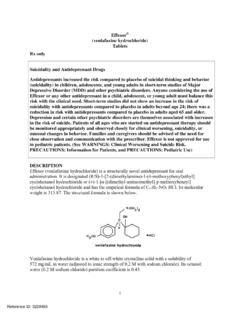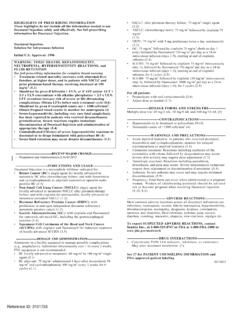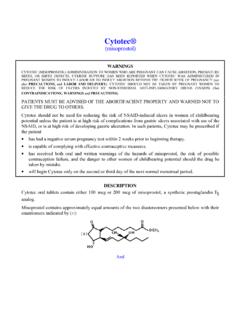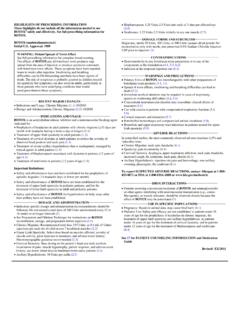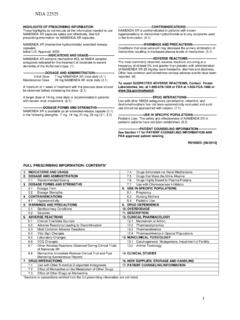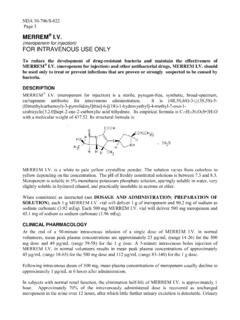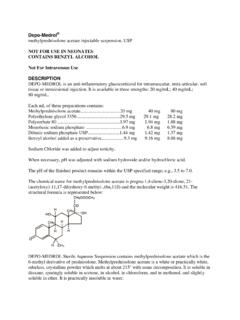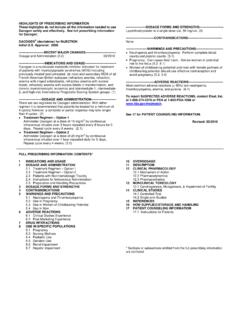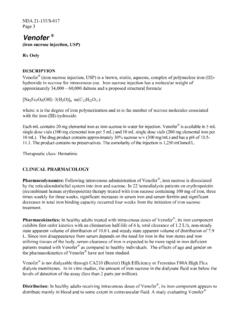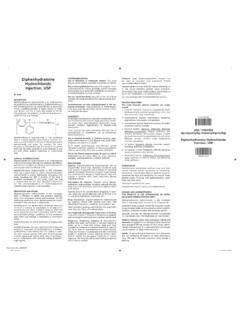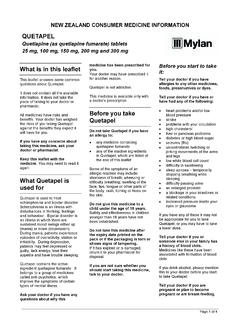Transcription of HIGHLIGHTS OF PRESCRIBING INFORMATION ...
1 HIGHLIGHTS OF PRESCRIBING INFORMATION These HIGHLIGHTS do not include all the INFORMATION needed to use SEROQUEL safely and effectively. See full PRESCRIBING INFORMATION for SEROQUEL.
2 SEROQUEL (quetiapine fumarate) tablets, for oral use Initial Approval: 1997 WARNING: INCREASED MORTALITY IN ELDERLY PATIENTS WITH DEMENTIA-RELATED PSYCHOSIS; and SUICIDAL THOUGHTS AND BEHAVIORS See full PRESCRIBING INFORMATION for complete boxed warning. Increased Mortality in Elderly Patients with Dementia-Related Psychosis Elderly patients with dementia-related psychosis treated with antipsychotic drugs are at an increased risk of death. SEROQUEL is not approved for elderly patients with dementia-related psychosis ( ) Suicidal Thoughts and Behaviors Increased risk of suicidal thoughts and behavior in children, adolescents and young adults taking antidepressants ( ) Monitor for worsening and emergence of suicidal thoughts and behaviors ( ) --------------------------RECENT MAJOR CHANGES ------------------------- Warnings and Precautions, Tardive Dyskinesia ( ) 08/2019 Warnings and Precautions, Leukopenia, Neutropenia and Agranulocytosis ( ) 11/2018 Warnings and Precautions, Anticholinergic (antimuscarinic) Effects ( )
3 11/2018 ---------------------------INDICATIONS AND USAGE ------------------------- SEROQUEL is an atypical antipsychotic indicated for the treatment of: Schizophrenia ( ) Bipolar I disorder manic episodes ( ) Bipolar disorder, depressive episodes ( ) ----------------------DOSAGE AND ADMINISTRATION --------------------- SEROQUEL can be taken with or without food ( ) Indication Initial Dose Recommended Dose Maximum Dose Schizophrenia Adults ( ) 25 mg twice daily 150-750 mg/day 750 mg/day Schizophrenia Adolescents (13-17 years) ( ) 25 mg twice daily 400-800 mg/day 800 mg/day Bipolar Mania Adults Monotherapy or as an adjunct to lithium or divalproex ( ) 50 mg twice daily 400-800 mg/day 800 mg/day Bipolar Mania Children and Adolescents (10-17 years)
4 , Monotherapy ( ) 25 mg twice daily 400-600 mg/day 600 mg/day Bipolar Depression Adults ( ) 50 mg once daily at bedtime 300 mg/day 300 mg/day Geriatric Use: Consider a lower starting dose (50 mg/day), slower titration and careful monitoring during the initial dosing period in the elderly ( , ) Hepatic Impairment: Lower starting dose (25 mg/day) and slower titration may be needed ( , , ) ---------------------DOSAGE FORMS AND STRENGTHS ------------------- Tablets: 25 mg, 50 mg, 100 mg, 200 mg, 300 mg, and 400 mg (3) ------------------------------CONTRAINDI CATIONS ---------------------------- Known hypersensitivity to SEROQUEL or any components in the formulation.
5 (4) -----------------------WARNINGS AND PRECAUTIONS --------------------- Cerebrovascular Adverse Reactions: Increased incidence of cerebrovascular adverse reactions ( , stroke, transient ischemic attack) has been seen in elderly patients with dementia-related psychoses treated with atypical antipsychotic drugs ( ) Neuroleptic Malignant Syndrome (NMS): Manage with immediate discontinuation and close monitoring ( ) Metabolic Changes: Atypical antipsychotics have been associated with metabolic changes. These metabolic changes include hyperglycemia, dyslipidemia, and weight gain ( ) Hyperglycemia and Diabetes Mellitus: Monitor patients for symptoms of hyperglycemia including polydipsia, polyuria, polyphagia, and weakness.
6 Monitor glucose regularly in patients with diabetes or at risk for diabetes Dyslipidemia: Undesirable alterations have been observed in patients treated with atypical antipsychotics. Appropriate clinical monitoring is recommended, including fasting blood lipid testing at the beginning of, and periodically, during treatment Weight Gain: Gain in body weight has been observed; clinical monitoring of weight is recommended Tardive Dyskinesia: Discontinue if clinically appropriate ( ) Hypotension: Use with caution in patients with known cardiovascular or cerebrovascular disease ( ) Increased Blood Pressure in Children and Adolescents: Monitor blood pressure at the beginning of, and periodically during treatment in children and adolescents ( ) Leukopenia, Neutropenia and Agranulocytosis.
7 Monitor complete blood count frequently during the first few months of treatment in patients with a pre-existing low white cell count or a history of leukopenia/neutropenia and discontinue SEROQUEL at the first sign of a decline in WBC in absence of other causative factors ( ) Cataracts: Lens changes have been observed in patients during long-term quetiapine treatment. Lens examination is recommended when starting treatment and at 6-month intervals during chronic treatment ( ) Anticholinergic(antimuscarinic) Effects: Use with caution with other anticholinergic drugs and in patients with urinary retention, prostatic hypertrophy, constipation, and increased intraocular pressure ( ).
8 ------------------------------ADVERSE REACTIONS ---------------------------- Most common adverse reactions (incidence 5% and twice placebo): Adults: somnolence, dry mouth, dizziness, constipation, asthenia, abdominal pain, postural hypotension, pharyngitis, weight gain, lethargy, ALT increased, dyspepsia ( ) Children and Adolescents: somnolence, dizziness, fatigue, increased appetite, nausea, vomiting, dry mouth, tachycardia, weight increased ( ) To report SUSPECTED ADVERSE REACTIONS, contact AstraZeneca at 1-800-236-9933 or FDA at 1-800-FDA-1088 or ------------------------------DRUG INTERACTIONS ---------------------------- Concomitant use of strong CYP3A4 inhibitors: Reduce quetiapine dose to one sixth when coadministered with strong CYP3A4 inhibitors ( , ketoconazole, ritonavir) ( , , ) Concomitant use of strong CYP3A4 inducers.
9 Increase quetiapine dose up to 5 fold when used in combination with a chronic treatment (more than 7-14 days) of potent CYP3A4 inducers ( , phenytoin, rifampin, St. John s wort) ( , , ) Discontinuation of strong CYP3A4 inducers: Reduce quetiapine dose by 5 fold within 7-14 days of discontinuation of CYP3A4 inducers ( , , ) 1 Reference ID: 4482034 -----------------------USE IN SPECIFIC POPULATIONS ----------------------See 17 for PATIENT COUNSELING INFORMATION and Medication Pregnancy: May cause extrapyramidal and/or withdrawal symptoms in Guide neonates with third trimester exposure.
10 ( ) Revised: 08/2019 FULL PRESCRIBING INFORMATION : CONTENTS* WARNING: INCREASED MORTALITY IN ELDERLY PATIENTS WITH DEMENTIA-RELATED PSYCHOSIS; AND SUICIDAL THOUGHTS AND BEHAVIORS 1 INDICATIONS AND USAGE Schizophrenia Bipolar Disorder Special Considerations in Treating Pediatric Schizophrenia and Bipolar I Disorder 2 DOSAGE AND ADMINISTRATION Important Administration Instructions Recommended Dosing Dose Modifications in Elderly Patients Dose Modifications in Hepatically Impaired Patients Dose Modifications when used with CYP3A4 Inhibitors Dose Modifications when used with CYP3A4 Inducers Re-initiation of Treatment in Patients Previously Discontinued Switching from Antipsychotics 3 DOSAGE FORMS AND STRENGTHS 4
